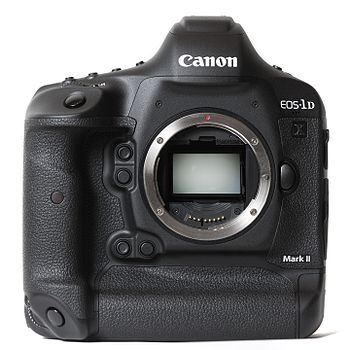 | |
| Overview | |
|---|---|
| Type | Digital single-lens reflex camera |
| Released | April 2016 |
| Intro price | US$ 5,999.00 |
| Lens | |
| Lens | Interchangeable (EF) |
| Sensor/medium | |
| Sensor type | CMOS |
| Sensor size | 36.0 × 24.0 mm (Full-frame) |
| Maximum resolution | 5472 × 3648 (20.2 effective megapixels) |
| Film speed | 100 – 51200 (expandable from L: 50 to H1: 102400; H2: 204800; H3: 409600) |
| Storage media | Dual slots: CFast 2.0 and CompactFlash (CF) Type I (UDMA-7 supported) |
| Focusing | |
| Focus modes | One-Shot, AI Servo, Manual |
| Focus areas | 61 AF points (41 cross-type AF points) with High-Density Reticular AF II |
| Exposure/metering | |
| Exposure modes | Program AE, Shutter priority AE, Aperture priority AE, Manual exposure, Bulb exposure, Custom, Movie |
| Exposure metering | approx. 360,000 pixel RGB+IR sensor, EOS iTR AF |
| Flash | |
| Flash | External |
| Shutter | |
| Shutter | Electromechanical carbon fiber focal-plane |
| Shutter speed range | 1/8000 s – 30 s, Bulb; X-sync at 1/250 s |
| Continuous shooting | 14 fps with full AF/AE tracking; 16 fps in Live View mode |
| Viewfinder | |
| Viewfinder | Eye-level pentaprism with 100% coverage and 0.76x magnification / LCD (Live View) |
| Image processing | |
| Image processor | DIGIC 6 and dual DIGIC 6+ |
| White balance | Available |
| WB bracketing | Available |
| General | |
| Video recording | 4096 × 2160 (DCI 4K), 59.94 fps, approx. 800 Mbps |
| LCD screen | 3.2" (8.1 cm) Clear View II colour TFT LCD touchscreen with 1,620,000 dots |
| Battery | LP-E19 |
| Body features | Dust and weather sealed magnesium alloy |
| Dimensions | 167.6 mm × 158 mm × 82.6 mm (6.60 in × 6.22 in × 3.25 in) |
| Weight | 1,340 g (2.95 lb) including battery, body only |
| Made in | Japan |
| Chronology | |
| Replaced | Canon EOS-1D X[1] |
| Successor | Canon EOS-1D X Mark III[2] |
The Canon EOS-1D X Mark II is a 20-megapixel full-frame DSLR flagship camera, announced on February 1, 2016, by Canon with an MSRP of US$5,999.00. It is the successor to the Canon EOS-1D X, which was released in 2012.[3][4]
On January 6, 2020, Canon introduced the Canon EOS-1D X Mark III as the successor to the EOS-1D X Mark II.[2]
- ^ "EOS-1D X Mark II". Canon Camera Museum.
- ^ a b "A Masterpiece In Engineering And Design: Canon Announces The EOS-1D X Mark III Camera". 2020-01-07. Retrieved 2020-02-01.
- ^ Alvarez, Edgar (1 February 2016). "EOS-1D X Mark II: Canon's flagship DSLR goes 4K". Engadget. Retrieved 2 February 2016.
- ^ Seymour, Tom (2 February 2016). "Canon launch The EOS-1D X Mark II – a flagship DSLR with 4K capability". British Journal of Photography. Retrieved 2 February 2016.